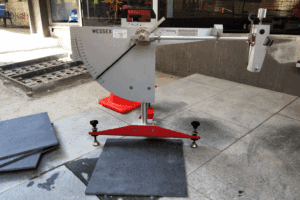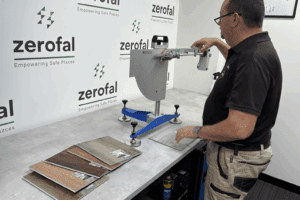Aged Care – Hygiene vs Safety
Clean floors can still be dangerous.
Infection control is critical in aged care – but cleaning routines can unintentionally raise the risk of slips and falls. This article outlines why visual hygiene isn’t enough and what testing can do to keep residents safe.
In aged care, hygiene is paramount—but not at the expense of safety.
Too often, infection control protocols drive cleaning and maintenance decisions without fully considering their impact on slip resistance. The result? Surfaces that are sanitised, sealed, and shiny – but dangerously slippery.
This tension between hygiene and safety isn’t hypothetical. It’s happening right now in facilities across Australia. And it’s putting residents, staff, and organisations at risk.
Hygiene Standards: Non-Negotiable
Aged care facilities must meet strict infection control standards. This includes:
- Frequent cleaning with approved chemicals
- Use of antimicrobial coatings
- Smooth, sealed surfaces for easy disinfection
- Wet mopping and machine scrubbing of hard floors
These are necessary for infection control—but they’re not neutral. They change the surface texture. And that changes how the floor performs when wet.
The Overlooked Risk: Slips and Falls
Slips and falls are one of the leading causes of injury in aged care. Residents are older, less stable, and more vulnerable to even minor environmental changes.
Here’s what we’re seeing:
- Sanitised floors lose microtexture. Repeated chemical cleaning, burnishing, or sealing creates a glossy finish that looks great but performs poorly.
- Polish, sealers and coatings reduce friction. Many common finishes significantly reduce wet pendulum scores—sometimes by two full P-classifications.
- Cleaners aren’t trained in slip risk. They’re assessed on hygiene, not friction. But their work affects both.
How to Resolve the Conflict
You don’t have to choose between hygiene and safety.
You need to measure both.
- Audit floor performance with AS 4663-2013. Test in-situ using wet pendulum or dry friction methods.
- Review finishes before application. Ask for AS 4586-2013 test reports with P or D ratings for all coatings and sealants.
- Train cleaning staff to recognise friction loss. If floors look shinier after treatment, test again.
- Use objective data, not visual cues. Shiny ≠ safe.
What We Do
Zerofal tests in-use floors to AS 4663-2013 and certifies new flooring finishes to AS 4586-2013. We work with facility managers, cleaners, and WHS teams to resolve hygiene/safety trade-offs with data.
If your aged care facility has upgraded its cleaning chemicals, changed floor coatings, or received a fall-related incident report, it’s time to test.
Don’t Assume. Test.
Maintaining dignity and safety for older Australians means more than keeping floors clean. It means keeping them walkable, too.
Contact Zerofal to book a test or interpret your surface data.
Prioritize Safety to Enhance Your Star Rating
Falls and major injuries are key components of the Aged Care Star Ratings’ Quality Measures. Ensure your facility meets the highest safety standards by proactively managing slip risks. Our certified slip resistance testing can help you identify and mitigate potential hazards, contributing to better outcomes for your residents and improved ratings.
Stay Ahead of Safety Standards
Join the Zerofal newsletter for actionable insights on slip testing, compliance updates, and smart prevention strategies. No spam – just practical safety advice.
Explore more

Colour, Grit and Surface Finish: How Subtle Differences Change Slip Ratings (AS 4586:2013)
Colour, grit and finish change slip resistance. Learn why P-ratings vary across tile ranges and coatings

Why One Slip Test Isn’t Enough for Product Lines (AS 4586:2013)
Slip resistance varies across colours and finishes. Learn why one AS 4586 test cannot certify an entire product line.

Industrial Slip Resistance: Dust, Boots & Coating Drift (AS 4663:2013)
: Industrial floors change fast. Learn how dust, coatings and machinery reduce slip resistance and why AS 4663 onsite testing is essential.
